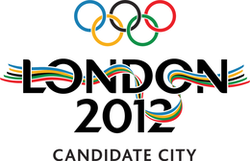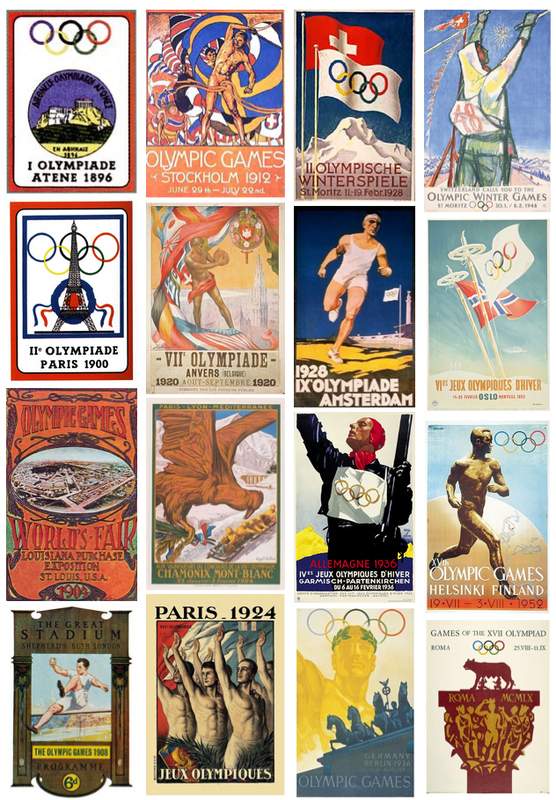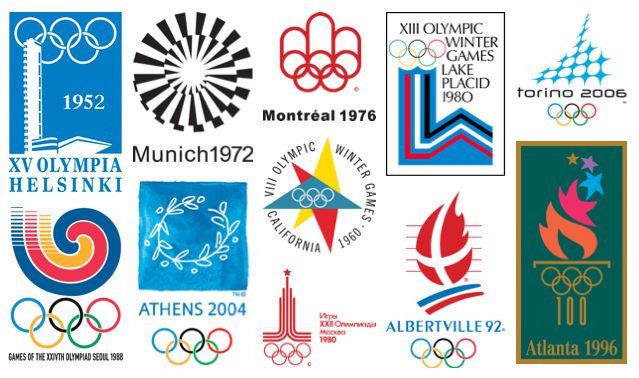:120728: My captors have designed a new emblem for their international sporting event. I think they could have done better.

Dear London 2012 Olympics,
Let's talk about your logo. In the bidding process for the 2012 Summer Olympic Games, Kino Design created a lovely image of a ribbon of the Olympic colors weaving through "London 2012" in the shape of your iconic River Thames. It was simple and eye-catching. It clearly stated the city and the year. It had an Olympic feel. It reflected a unique aspect of the host city. It was everything an Olympic logo should be. Your logo for the actual Games, by Wolff Olins, not so much.
I understand that your goal was to reach young people. You probably should have asked some young people (or, you know, people) what they thought of the design. Young people aren't just bright colors and hard-to-read, though it may seem like that sometimes. Young people appreciate good design as much as the next person. Maybe more so. Ugly does not equal young. The BBC ran a poll in which more than 80% of those surveyed awarded the design the lowest possible rating. Maybe that should have been a hint.
There are many directions you could have taken with this logo business.
Early in the modern Olympic era, the logos were similar, and though they started out fairly plain, they soon transformed into more poster-like advertisements for the Games. Although not all of them succeed on all counts, most of them are simple, eye-catching, have an Olympic feel, and reflect the host city.
Let's talk about your logo. In the bidding process for the 2012 Summer Olympic Games, Kino Design created a lovely image of a ribbon of the Olympic colors weaving through "London 2012" in the shape of your iconic River Thames. It was simple and eye-catching. It clearly stated the city and the year. It had an Olympic feel. It reflected a unique aspect of the host city. It was everything an Olympic logo should be. Your logo for the actual Games, by Wolff Olins, not so much.
I understand that your goal was to reach young people. You probably should have asked some young people (or, you know, people) what they thought of the design. Young people aren't just bright colors and hard-to-read, though it may seem like that sometimes. Young people appreciate good design as much as the next person. Maybe more so. Ugly does not equal young. The BBC ran a poll in which more than 80% of those surveyed awarded the design the lowest possible rating. Maybe that should have been a hint.
There are many directions you could have taken with this logo business.
Early in the modern Olympic era, the logos were similar, and though they started out fairly plain, they soon transformed into more poster-like advertisements for the Games. Although not all of them succeed on all counts, most of them are simple, eye-catching, have an Olympic feel, and reflect the host city.
Posters eventually gave way to more logo-like representations of a particular Olympic Games, but for many years, each Games had both a logo and a poster (or several). Often, the posters and logos complemented each other, like your own 1948 Games.

That's a beautiful logo, by the way. You could have used the exact same logo again, and just changed the 1948 to 2012.
It's been done before.
Early logos were official-looking affairs, all monotone and seal-like. This is certainly the type of thing to be avoided if you're looking to appeal to a younger crowd, and yet the Olympic Games represent more than 100 years of international competition in the modern era. There's nothing wrong with honoring a little bit of history (like you did so well in your opening ceremony).
Another option would have been to make it painfully obvious that you're the host country. Make the Union Jack the focal point, so nobody can forget the London 2012 happened in the UK. This was the strategy taken by both Los Angeles Games, and two of the three games held in Japan.
Although it seems easiest to accomplish this with a Winter Games, you could have gone with a motif that represents the season, or a particular sport. Snowflakes, like Sapporo above, seem to be a popular choice. Lillehammer used a representation of the aurora, and though St. Mortiz was a Winter Games, the sunshine seems to work.

If you were going for appeals-to-youth, there's always the tried-and-true rainbow stylized athlete. I wasn't really a fan of this when I first saw it in Barcelona, nor have I been a fan all of the times it has appeared since then, but it seems to work. Again, we're looking for simple and eye-catching (and easy to read), Olympic spirit (Olympic colors, depiction of athletes, sense of movement), and reflection of the host city. All of these rainbow stylized athlete logos accomplish that.
A sport, a torch, or simply an abstraction (of strength, grace, movement, power, or an element of the host city). Simple and eye-catching. Easy to read. Olympic spirit. Reflection of the host city. More than one of the above are required for a good Olympic logo.
But I see what you were trying to do. You wanted the text itself to be the design. Well-designed text can make for an elegant, stunning, simple, powerful logo. But it's not easy to do.

Amsterdam did alright. Simple, easy to read.
Mexico did it better: simple, easy to read—add eye-catching, sense of movement, and a clever incorporation of the Olympic Rings into the year.
I wouldn't call either of these spectacular logos, but they certainly get the job done. Amsterdam's poster does a much better job (see above).
Mexico did it better: simple, easy to read—add eye-catching, sense of movement, and a clever incorporation of the Olympic Rings into the year.
I wouldn't call either of these spectacular logos, but they certainly get the job done. Amsterdam's poster does a much better job (see above).
And yet, with over a century of examples, ranging from excellent to mediocre, you came up with this monstrosity. It hurts my eyes. Animated footage of it triggered seizures in viewers with photosensitive epilepsy. How many people approved the design before it became official?

It is eye-catching (in that seizure-inducing way), although it takes a while to figure out what you're really looking at.
The city is easy to read, though not capitalized. While in some cases lack of capitalization can look young, hip, and modern—in this case it just looks sloppy.
There is a sense of movement portrayed here, but instead of speed, agility, and grace as one would expect from an Olympic athlete, this movement evokes earthquake aftermath.
There is no Olympic spirit. The year is illegible. There is nothing to indicate the host city besides the word. The Olympic colors are absent. The colors of the host country's flag are absent, too.
It's not pleasing to look at. From a distance, it doesn't look like anything at all.
Now, London, I understand that it was a design firm and not you responsible for this particular design, but it's possible to make your design firm start over. It's even possible to fire your design firm and hire another one. Like maybe the one that did your candidate city logo. That one was nice.
I realize it's too late now, so just know that you've won the gold—for worst Olympic logo ever.
The city is easy to read, though not capitalized. While in some cases lack of capitalization can look young, hip, and modern—in this case it just looks sloppy.
There is a sense of movement portrayed here, but instead of speed, agility, and grace as one would expect from an Olympic athlete, this movement evokes earthquake aftermath.
There is no Olympic spirit. The year is illegible. There is nothing to indicate the host city besides the word. The Olympic colors are absent. The colors of the host country's flag are absent, too.
It's not pleasing to look at. From a distance, it doesn't look like anything at all.
Now, London, I understand that it was a design firm and not you responsible for this particular design, but it's possible to make your design firm start over. It's even possible to fire your design firm and hire another one. Like maybe the one that did your candidate city logo. That one was nice.
I realize it's too late now, so just know that you've won the gold—for worst Olympic logo ever.













 RSS Feed
RSS Feed
